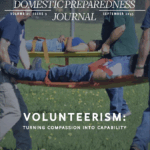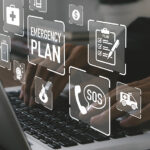Over the years, emerging technologies have played a crucial role in enhancing the effectiveness and efficiency of emergency management efforts. This five-part series looks at some of the more prominent emerging technologies in all-hazards emergency management and presents a classification scheme for these technologies.
Emerging technologies are innovative and cutting-edge advancements in various fields, such as information technology, telecommunications, sensor networks, data analytics, robotics, and artificial intelligence. These technologies show the potential to significantly improve the capabilities and performance of emergency management processes, including preparedness, response, recovery, and mitigation. Emerging technologies offer novel approaches, tools, and solutions to complex challenges posed by disasters and emergencies, enabling more effective decision-making, resource allocation, and stakeholder coordination.
Classification of Emerging Technologies
Emerging technologies are classified based on their application and potential impact on various phases of emergency management. Broad classifications include information and communication technologies, uncrewed vehicles, artificial intelligence and machine learning, and robotics and automation.
In an era of rapid technological advancement, the convergence of information and communication technologies (ICT) with emergency management, disaster response, and humanitarian relief efforts is revolutionizing how societies approach and mitigate crises. The dynamic interplay between technology and critical sectors has birthed a new paradigm in crisis management that enables real-time data acquisition, efficient communication, and targeted resource allocation, even in the face of the most formidable challenges. From natural disasters to complex emergencies, ICTs have emerged as invaluable tools, empowering responders, aiding survivors, and enhancing the overall effectiveness of disaster and humanitarian initiatives.
In modern technology, a remarkable revolution has occurred in uncrewed vehicles – a technological innovation has reshaped industries, expanded possibilities, and transformed how uncrewed vehicles interact with the world. Uncrewed vehicles, often called autonomous systems or drones, have transcended the traditional boundaries of human-operated vehicles, introducing a new era of automation and autonomy. These vehicles, equipped with cutting-edge sensors, communication systems, and advanced computing, have unlocked many applications across land, sea, and air domains. The intricate world of uncrewed vehicles unveils a tapestry of innovation with significance, capabilities, and myriad ways in which they can shape the future of emergency management.
In the rapidly evolving technology landscape, artificial intelligence (AI) and machine learning have emerged as groundbreaking paradigms, reshaping how people perceive and interact with the world. AI, in its essence, aims to infuse machines with human-like cognitive abilities, enabling them to perform tasks that typically require human intelligence. Machine learning, a subset of AI, is the driving force behind the recent explosion in AI capabilities. It empowers computers to learn from data without being explicitly programmed.
In emergency management, disaster response, and humanitarian relief, the integration of robotic systems and automation has emerged as a transformative force, revolutionizing how societies prepare for and respond to crises. Rapid advancements in technology have ushered in an era where robotics and automation are no longer confined to science fiction but rather play pivotal roles in addressing pressing challenges during times of catastrophe. From natural disasters like earthquakes, hurricanes, and wildfires to complex humanitarian crises, the synergy between human ingenuity and robotic precision has led to innovative solutions that enhance emergency operations’ efficiency, effectiveness, and safety.
Enhancing Capabilities
Emerging technologies continue revolutionizing all-hazards emergency management by providing innovative solutions and improving the overall response to disasters and emergencies. As technology advances, emergency management professionals and policymakers need to remain vigilant and adopt innovative tools to enhance their capabilities and protect their communities from the impacts of disasters.
For example, ICT encompasses technologies and tools that facilitate efficient and effective information exchange, processing, and dissemination. By supplying real-time data, communication channels, and decision support systems, ICT enables responders to make informed decisions, coordinate efforts, and deliver aid more effectively during disasters and emergencies.
ICTs are diverse technologies that integrate communication and information processing capabilities. It encompasses hardware, software, networks, and services that facilitate data collection, storage, processing, transmission, and presentation.
Anatomy of the Information and Communication Infrastructure
 The communication infrastructure is composed of telecommunications networks and internet connectivity. Telecommunication networks are the traditional telephonic networks and modern cellular and satellite communications that ensure redundant and resilient communication channels for responders and affected communities. High-speed internet connectivity provides access and enables real-time data exchange, social media engagement, and stakeholder collaboration.
The communication infrastructure is composed of telecommunications networks and internet connectivity. Telecommunication networks are the traditional telephonic networks and modern cellular and satellite communications that ensure redundant and resilient communication channels for responders and affected communities. High-speed internet connectivity provides access and enables real-time data exchange, social media engagement, and stakeholder collaboration.
Information management systems include geographic information systems (GIS) and early warning systems. GIS platforms help visualize and analyze geographic data, enabling responders to understand the spatial aspects of the disaster and make informed decisions about resource allocation and evacuation routes. Emergency Operations Centers use integrated software platforms to support emergency management personnel in coordinating response efforts, requesting and tracking resources, and obtaining, maintaining, and sharing a common operating picture. Early warning systems facilitate the dissemination of early warning messages via short message service (SMS), mobile applications, and other communication channels, warning and notifying communities about imminent threats and providing instructions on what to do and where to go.
Data analytics and visualization encompass big data analytics that process and analyze large datasets to help identify patterns and trends, enabling authorities to predict and respond to emergencies more effectively. Data visualization tools provide a graphical representation of data, facilitating an understanding of complex information and supporting the decision-making processes.
Social media platforms and crowdsourcing are valuable ways to contribute and disseminate information. During emergencies, social media platforms like X (formerly Twitter), Facebook, and WhatsApp are helpful channels for sharing information, conducting public awareness campaigns, and engaging affected communities. Crowdsourcing allows citizens to contribute real-time information about the disaster’s impact, allowing responders to gain situational awareness and identify critical needs.
Uncrewed vehicles (also known as drones) and maritime autonomous systems provide imagery and surveillance capabilities, aiding in damage assessment and search-and-rescue operations and identifying access routes in hard-to-reach areas.
Examples of ICT Applications
These are examples of ICT applications used to respond to and manage emergencies:
- In response to the devastating 2010 earthquake in Haiti, Ushahidi, an open-source crisis mapping platform, was deployed to aggregate and visualize crisis information from various sources. The platform collected data from SMS, social media, and other channels, helping responders identify areas needing immediate aid and providing valuable situational awareness.
- After the Fukushima Daiichi Nuclear Disaster in 2011, Japan used ICT to monitor radiation levels and share data with the public. The Japanese government utilized the System for Prediction of Environmental Emergency Dose Information (SPEEDI) system. Japan also used a sophisticated earthquake early warning system called “J-Alert,” which uses various ICT technologies, including seismic sensors and satellite communication. This system provides real-time alerts to the public through television, radio, and mobile apps.
- After the Nepal earthquake in 2015, Sahana Eden, an open-source disaster management platform, was used extensively during the response. The platform facilitated the registration of affected people, tracking relief supplies, and coordinating response efforts among various organizations. It provided a centralized database for decision-makers to understand the evolving situation and prioritize resources. In addition, volunteers and organizations used OpenStreetMap (OSM) to create detailed crisis maps of affected areas. This crowdsourced data helped aid organizations plan their relief efforts effectively.
- During Hurricane Harvey in 2017, social media platforms like Twitter, Facebook, and Instagram played a significant role in providing real-time information about the disaster. Citizens use these platforms to share updates, request help, and report emergencies. Organizations like the National Weather Service and the Federal Emergency Management Agency also used social media to disseminate information. While not a specific ICT system or manufacturer, the use of these platforms demonstrated the power of crowdsourced data in disaster response.
- After Hurricane Maria struck Puerto Rico in 2017, Drones assessed infrastructure damage, delivered medical supplies, and inspected hard-to-reach areas. Companies like DJI provide drones for disaster relief efforts.
- During the COVID-19 pandemic response, which began in 2020, many countries developed contact tracing applications to help identify and isolate individuals who may have been exposed. Examples include the NHS COVID-19 app in the UK and the Aarogya Setu app in India. Singapore’s TraceTogether and Ireland’s COVID Tracker rely on Bluetooth technology. Government agencies and private companies have developed contract tracing apps.
- During wildfires in California, remote sensing and GIS technology from NASA’s Fire Information for Resource Management System (FIRMS) are used to monitor the spread of wildfires, assess their impact, and plan evacuation routes. Agencies like CAL FIRE and the California Governor’s Office of Emergency Services (CalOES) utilize GIS software and tools from companies like Esri to map fire perimeters, track evacuation routes, and allocate resources effectively.
In conclusion, ICTs are integral to all-hazards emergency management, humanitarian relief, and disaster response efforts. Responders can enhance their situational awareness, coordination, and decision-making processes during emergencies by leveraging communication networks, data analytics, social media, and other ICT tools. The examples cited above demonstrate how ICT has been instrumental in improving disaster response and recovery efforts, underscoring these technologies’ critical role in saving lives and mitigating the impacts of disasters. Integrating ICT into emergency management strategies remains pivotal in building resilient and efficient disaster response systems as technology advances.
Other articles in this series:
Parts 2-5 will examine other emerging technologies and consider how modern emergency managers can integrate them into their all-hazards emergency management plans, policies, and procedures.
Part 1 – Information and Communication
Part 3 – Artificial Intelligence and Machine Learning
Part 4 – Robotics and Automation
Part 5 – Legal and Privacy Concerns

Ian Pleet
Ian Pleet is committed and dedicated to serving as an outstanding example of an emergency management professional with over thirty years of hands-on expertise. He is widely recognized as an adept manager of high-risk emergencies, with a strong focus on addressing chemical, biological, radiological, nuclear, and explosive threats (CBRNE), as well as weapons of mass destruction (WMD) and infectious diseases. His record of accomplishment is marked by the successful design and execution of exercises, delivering adult education using high-fidelity simulations, and establishing effective incident management systems during emergency responses. Moreover, Mr. Pleet is renowned for his ability to advocate policy and oversee program reviews, and he is considered an authority in risk management. He plays an active role in emergency management as an instructor for emergency management and incident command courses, contributing to industry publications and providing technical oversight for textbooks before publication. He is a pro-board-certified fire officer IV, FEMA Professional Continuity Practitioner, and DoD Antiterrorism Officer.
- Ian Pleethttps://domesticpreparedness.com/author/ian-pleet
- Ian Pleethttps://domesticpreparedness.com/author/ian-pleet
- Ian Pleethttps://domesticpreparedness.com/author/ian-pleet
- Ian Pleethttps://domesticpreparedness.com/author/ian-pleet





